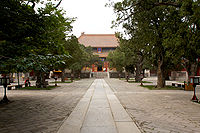
Beijing Temple of Confucius
Encyclopedia

Beijing
Beijing , also known as Peking , is the capital of the People's Republic of China and one of the most populous cities in the world, with a population of 19,612,368 as of 2010. The city is the country's political, cultural, and educational center, and home to the headquarters for most of China's...
(北京孔庙) is the second largest Confucian Temple in China
China
Chinese civilization may refer to:* China for more general discussion of the country.* Chinese culture* Greater China, the transnational community of ethnic Chinese.* History of China* Sinosphere, the area historically affected by Chinese culture...
, after the one
Temple of Confucius, Qufu
The Temple of Confucius in Qufu, Shandong Province of China, is the "original", largest and most famous of the temples of Confucius in China and East Asia....
in Confucius' hometown of Qufu
Qufu
Qufu is a city in southwestern Shandong province, People's Republic of China. It is located at 35° 36′ northern latitude and 117° 02′ east, about south of the provincial capital Jinan and northeast of the prefecture seat at Jining...
.
The temple was built in 1302, and officials used it to pay their respects to Confucius until 1911. The compound was enlarged twice, during the Ming
Ming Dynasty
The Ming Dynasty, also Empire of the Great Ming, was the ruling dynasty of China from 1368 to 1644, following the collapse of the Mongol-led Yuan Dynasty. The Ming, "one of the greatest eras of orderly government and social stability in human history", was the last dynasty in China ruled by ethnic...
and Qing
Qing Dynasty
The Qing Dynasty was the last dynasty of China, ruling from 1644 to 1912 with a brief, abortive restoration in 1917. It was preceded by the Ming Dynasty and followed by the Republic of China....
dynasties and now occupies some 20,000 square meters. From 1981 until 2005, the Temple of Confucius also housed part of the art collection of the Capital Museum
Capital Museum
The Capital Museum located at 16 Fuxingmenwai Dajie, Xicheng District is an art museum in Beijing, China. It opened in 1981 while the present building was built in the late 1990s and it houses a variety of items from Imperial China as well as other Asian cultures...
. It stands on Guozijian Street
Guozijian Street
Guozijian Street , formerly known as Chengxian Street , is a street in Dongcheng District, Beijing. It is listed as an important historical site....
near the Imperial Academy
Guozijian
The Guozijian , or Kuo Tzu Chien, the School of the Sons of State, sometimes called the Imperial Academy, Imperial College, Imperial Central School, was the national central institute of learning in Chinese dynasties after the Sui. It was the highest institute of learning in China's traditional...
.
The complex includes four courtyards aligned along a central axis. From south to north, noteworthy structures includes the Xianshi Gate (先师门), Dacheng Gate (Gate of Great Accomplishmen, 大成门), Dacheng Hall (Hall of Great Accomplishment, 大成殿) and Chongshengci (崇圣祠). Inside the temple there are 198 stone tablets positioned on either side of the front courtyard, and they contains more than 51,624 names of Jinshi (advanced scholars) of the Yuan, Ming and Qing dynasties, and 14 stone stele pavilions of the Ming and Qing dynasties that hold various historical documents of ancient China.
The temple also contains stone tablets recording the names of many generations of scholars who passed the Imperial Examination
Imperial examination
The Imperial examination was an examination system in Imperial China designed to select the best administrative officials for the state's bureaucracy. This system had a huge influence on both society and culture in Imperial China and was directly responsible for the creation of a class of...
, a reproduction of a Western Zhou
Western Zhou
The Western Zhōu period was the first half of the Zhou Dynasty of ancient China. It began when King Wu of Zhou overthrew the Shang Dynasty at the Battle of Muye. C.H...
period stone drum made during the reign of Qianlong (1735-96), and stone stele
Stele
A stele , also stela , is a stone or wooden slab, generally taller than it is wide, erected for funerals or commemorative purposes, most usually decorated with the names and titles of the deceased or living — inscribed, carved in relief , or painted onto the slab...
s containing the Thirteen Confucian Classics, presented by the city of Jintan
Jintan
Jintan is a county-level city within Changzhou in Jiangsu province of the People's Republic of China.-Location:Jintan, is located in Jiangsu province in the south, surrounded by Shanghai, Hangzhou and Nanjing. The name Jintan developed from Jinshan county, which continued to be used up to now...
in Jiangsu Province.
There is set of carved stone drums made between 1736-1795 during the Qianlong period of the Qing Dynasty held within the Gate of Great Accomplishment, and there is also a large collection of ancient Chinese musical instrument located within the Hall of Great Perfection, along with the central shrine to Confucius.
There are various carvings inside the temple ground. One notable example is a famous carving of "two flying dragons playing a pearl among clouds"; this rare image is seldom to be found in other Confucius temples in China or East Asia, and it is often used in the imperial palaces as dragon is usually solely reserved for emperors.
The Temple has many old trees, including one Cypress tree known as the "Touch Evil Cypress" (Chu Jian Bai), that has been made famous by folklore through the ages. Its name derives from a story from the Ming Dynasty that when a famously corrupt official was passing by, the tree knocked off his hat, and since then people have thought this particular tree could distinguish between good and evil.
External links
- Full Virtual Walk & Info on Confucius Temple, Beijing
- http://baike.baidu.com/view/23902.htm (in Chinese)

